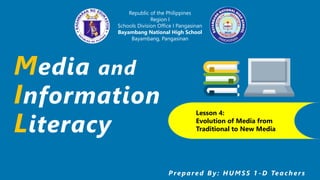This document discusses the evolution of media from traditional to new media. It describes the four major media ages: pre-industrial age, industrial age, electronic age, and information age. Examples of technologies used for communication, information storage, and broadcasting are provided for each age, ranging from clay tablets and cave paintings to the internet, social media, and mobile devices. The key differences between traditional and new media are also outlined.























































